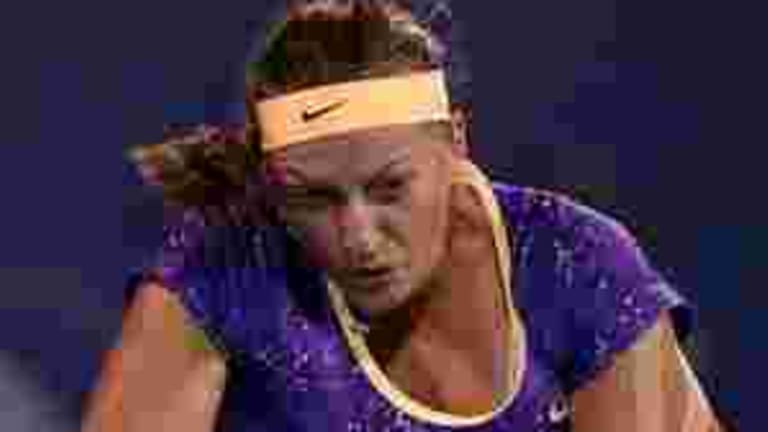
Dubai: Kvitova d. Errani
The Czech turns things around to win a see-saw final.
Published Feb 23, 2013

Dubai: Kvitova d. Errani
As I watched Petra Kvitova win her ninth consecutive set at this year’s Dubai Duty Free Tennis Championships—an overpowering 6-2 effort that could have easily been a shutout (the Czech hit 19 winners; Sara Errani hit but one)—I was reminded of Juan Martin del Potro. Kvitova and the Argentine have a lot in common: Short takebacks, heavy and flat groundstrokes, low net clearance. They are both tall players who move well for their size, and are nearly unstoppable when they’re ‘on.’ And Kvitova certainly was ‘on’ in the first set.
They also own one Grand Slam singles title apiece thus far. I say ‘thus far’ because I expect their games to yield more major trophies; it's surprising to me that neither has won a second Slam already. For del Potro, injuries are a big reason, but not the only one. His game, like Kvitova’s, is prone to wild swings. It’s rare to see Serena Williams, Victoria Azarenka, or any the ATP’s Big Four lose a set convincingly—they are all great players because of particular shots, but also because of their consistency. That can't be said about del Potro, or Kvitova, who went on to lose the final six games of a 6-1 second set.
But Kvitova's ability to then take the final set by the same score, thus earning her the Dubai title, is another reason I believe she’s a multiple-major champion in the making.
After Kvitova broke Errani to open the second set, this final appeared all over but the ceremony. Errani’s all-court game, which has taken her to the French Open final and the WTA Top 10, was powerless against Kvitova, who dictated play in baseline exchanges and terminated the rallies—for better or worse—on nearly every point. The 2011 Wimbledon champion hit some exceptional winners off both sides, and those she struck on the run were some of the best I’ve seen this season.
The only thing holding Kvitova back from perfection was her serve, which didn’t overwhelm Errani like the rest of her game. The Italian returned well, but Kvitova also double-faulted frequently. When that added up to Errani’s first break of the day in the second game of the second set, the match turned completely.
Kvitova’s forehands now found the net and strayed outside the lines while her serve disintegrated, and Errani’s confidence grew with each passing game. Now, Errani’s net play was bearing fruit and frustrating her opponent, and her shots were hit earlier and at sharper angles. She is the quicker and more nimble of the two combatants, and that put more pressure on Kvitova, who seemed to fold mentally. It’s not the first time we’ve seen that happen, but it was no less shocking after such a one-sided opening set.
The conclusion of the second set turned out to be the best thing for Kvitova in the end. Both players hit the reset button with the match all square, and that played a part in three tough holds, starting with Kvitova, to open the third set. Who would blink first? Not Kvitova, who in the third game fought back from 0-40, preventing Errani from taking the lead for the first time. Kvitova’s focus was back, and gradually, her shotmaking returned as well. By the end of the match, her grunt made an appearance, signifying that the total package was on display. Like in set one, Errani’s weapons were no match for Kvitova’s impressive arsenal.
It was not Kvitova’s prettiest performance, as 6-2, 1-6, 6-1 matches tend to be, but it was an important victory. To lose a final after defeating Ana Ivanovic, Agnieszka Radwanska, and Caroline Woznaicki in straight sets—and after leading Errani by a set and a break—would have been a demoralizing end to an otherwise superb week. Now, Kvitova heads into the Indian Wells and Miami tournaments on a high note; perhaps only Victoria Azarenka is playing better at the moment. We’ll see if that carries over into the two big hard-court events, where, amazingly, Kvitova has never been beyond the third round.